La traversée du Golfe de Gascogne fait environ 350 miles, et se fait en trois jours. Nous sommes partis depuis 24h, et nous en avons parcouru … 15.
Pour notre dernière (et première) traversée du golfe, nous avions un pilote automatique. On s’était dit que ce serait ballot qu’il tombe en panne, et que ce serait pas plus con d’en avoir un deuxième en secours. Comme on a de la suite dans les idées, on a installé un pilote secondaire. Or, maintenant que nous sommes au large, on réalise qu’il ne marche pas, et que notre pilote d’origine ne marche plus non plus. Bref, nous sommes arrêtés à port Haliguen, à deux heures de la Trinité Sur Mer dont nous sommes partis, et nous attendons le technicien qui a installé le pilote. On constate que ça ne marche pas, il fait une mise à jour, on constate que ça marche, et nous voilà partis pour de bon, avec 24h de retard. Notre pilote principal fonctionne aussi, il voulait juste redémarrer. Comment n’y ai-je pas pensé ; pour un informaticien, ça fait désordre.
Le seul souci, c’est que les 24h qu’on a perdues n’ont pas été perdues pour tout le monde. On devait arriver jeudi soir, juste avant que l’immense dépression qui fonce sur nous ne s’installe. Finalement, elle devrait nous accompagner pour le dernier tiers du voyage. D’un autre côté, c’est ça ou attendre deux semaines qu’elle – et surtout la houle qu’elle aura levé – s’en aille. On en a marre de la Trinité sur Mer, marre de la Bretagne, marre des travaux, on veut manger des tapas et parler Espagnol. Nous partons, donc.
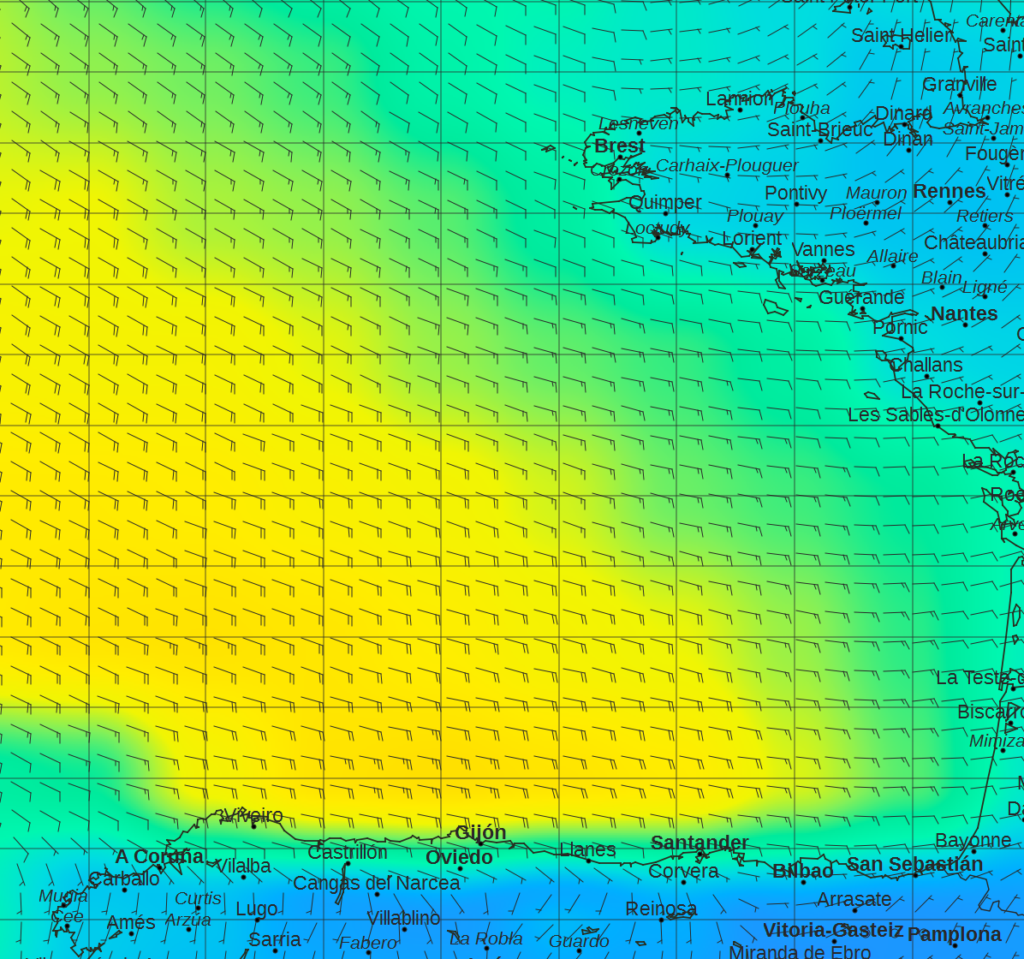
Les prévisions pour notre arrivée à la Corogne. Ca sent la vilaine houle d’Est.
La mer est calme, nous voyons Belle-Ile diminuer au loin. On a encore assez de réseau pour que je reçoive un SMS de ma mère qui m’explique qu’elle s’est enfermée chez moi en essayant de changer ma serrure, mais nous n’aurons l’épilogue que dans quelques jours. Certains font des cures de désintox digitale à la campagne ; nous avons choisi la formule extrême. Notre seul moyen de communication est un irridium, qui met 2 minutes à envoyer un mail d’une page, dont personne n’a le numéro à part nos mamans, et dont les tarifs rappellent la téléphonie du 20ème siècle. Et le combiné…oh le combiné … on croirait une sorte de nokia 33 10 auquel ou aurait oublié de mettre le serpent. En un mot comme en mille, nous sommes seuls, et nous aurons bientôt le sentiment bizarre d’être les uniques humains vivants a quelques centaines de km à la ronde
Il y a moins de vent que prévu, il ne vient pas d’où il est censé venir, et nous nous rendons compte que la moyenne de 6 nœuds sur laquelle nous tablions était peut-être un peu ambitieuse. Arriverons-nous samedi matin dans la tempête ? Le pire, c’est qu’au milieu de chaque traversée, on se dit qu’on aurait du prendre 5 nœuds.
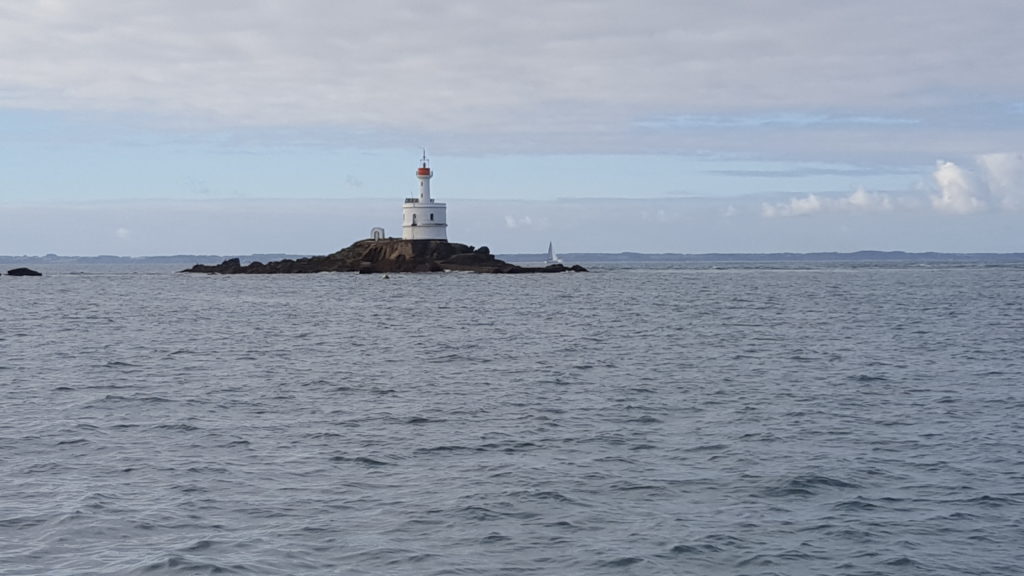
Le phare de la Teignouse, maintes fois passé ces trois derniers mois. Il va nous manquer !
La première nuit se passe calmement, nous nous relayons pour dormir, nous mangeons des pizzas maison, un dauphin solitaire vient sauter devant notre étrave, un petit oiseau venu de nulle part vient se poser dans le cockpit, la lune est presque pleine, et nous fonçons vers l’Espagne. Soudain, nous nous ne retrouvons cernés par une dizaine de ferrys et cargos, qui auront deux heures plus tard tous disparu au large. Nous avons probablement croisé sans le savoir une route de transit non indiquée sur notre carte.
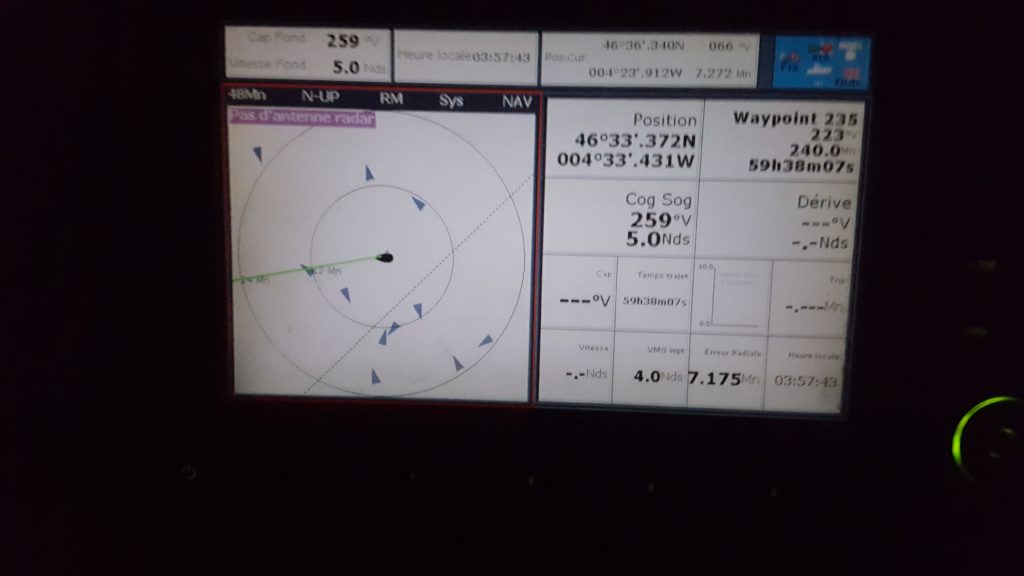
Et dire qu’il y a deux heures nous étions seuls au monde !
Le lendemain, nous envoyons même le spi, qui nous gratifie de quelques pointes à 9 nœuds. Sarah arrive même à battre le pilote en prenant la barre et à nous pousser à 9.9 ; elle exulte ! Au soir, le vent a forcit et nous sommes revenus à notre combo initial grand-voile / génois. La prudence commande de réduire la voilure pour la nuit. Un ris est toujours plus simple à prendre de jour que de nuit, et personne ne s’est jamais retrouvé en galère pour avoir pris un ris trop tôt, tout juste en retard pour l’apéro à l’arrivée au port. C’est le point de vue de Sarah. Nous avons actualisé notre météo par satellite, et les gribs sont formels, le vent ne bougera plus jusqu’à notre atterrissage à Cabo Ortegal. Je suis donc plutôt d’avis de garder la voilure pleine, et Sarah se laisse convaincre (elle est de toute façon trop fatiguée pour argumenter). Il est 21h et je vais me coucher.
Minuit. Je dors depuis quelques heures, et je commence à me sentir bien dans mon lit. Nous avons émigré dans la cabine arrière pour la traversée, car elle est plus stable et plus proche de la personne de quart. Je me réveille en sursaut quand Sarah me verse de l’eau de mer glacée dans le cou – en tout cas c’est ce que j’ai cru qui se passait au moment précis où c’est arrivé ; En fait, nous avions mal fermé un hublot du cockpit, et une vague prise avec le mauvais timing s’est chargée de nous rappeler qu’il faut toujours, toujours fermer tous les hublots. Je me lève donc, un peu ronchon, et croise Sarah qui venait me réveiller. « Il faut réduire ». Elle ne rajoute pas « je te l’avais pourtant dit », mais je le sens bien dans ses yeux et elle n’a pas totalement tort. Mine de rien, ça fait deux heures qu’elle galère à essayer de tenir un bateau surtoilé pour me laisser dormir …
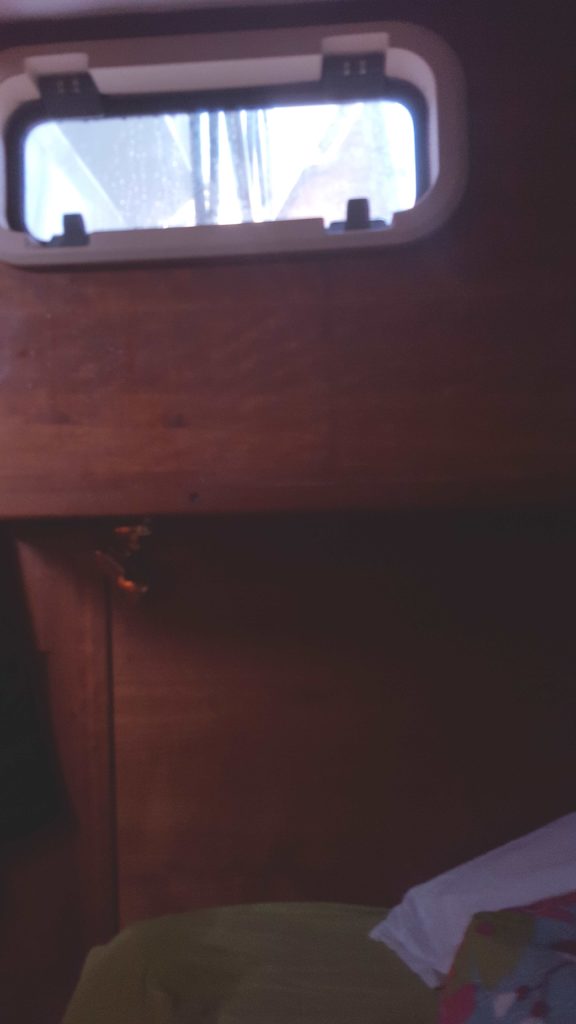
En plissant les yeux, on parvient à distinguer des coulures d’eau sur le bois et une tache mouillée sur l’oreiller. Cette phot n’a aucun interêt, mais sur le moment, j’ai voulu garder des preuves, au cas ou je puisse incriminer Sarah
Le vent a nettement forci. Nous avons maintenant 6bft avec de bonnes rafales, et Lucy fait départ au lof sur départ au lof. Notre cher Raymarine n’arrive pas à les récupérer correctement, et nous n’osons même pas essayer notre nouveau pilote. Il faut réduire, donc. Nous enroulons le génois, Sarah installe l’étai largable que nous aurions vraiment du mettre en place plus tôt, et la trinquette qui était déjà dans son sac de pont, nous prenons deux ris, et Lucy gagne un demi nœud. Forcément, ça marche mieux sans avoir en permanence un safran perpendiculaire au bateau …
Cinq heures du matin. Sarah se repose. Le vent souffle de plus belle, et notre éolienne donne le spectacle de sa vie. La mer commence à être forte avec quelques déferlantes de 3m. Bien entendu, c’est le moment que choisi notre vénérable RayMarine pour afficher « no data ». Je suis sûr que son capteur d’angle de barre s’est débranché, mais impossible d’aller ouvrir en solo le coffre situé dans la jupe pour le remettre en place en pleine nuit avec 3m de creux. Je bascule sur notre pilote secondaire que nous avons vraiment bien fait d’installer avant de partir. Merci à Antoine, Xavier, et tous ceux qui nous ont interdit de partir sans un deuxième pilote !
Je suis crevé, mais le spectacle est splendide. Je barre un peu sous les étoiles, la mer est magnifique, la lune surgit d’un coup et inonde l’écume de sa clarté blafarde. Sur l’AIS, je vois que nous suivons a une 20aine de miles un voilier de 144 pieds, Fryderyk Chopin. J’aimerai bien le rattraper, mais nous lui rendons facilement un nœud en permanence. J’ai vraiment du mal à rester éveillé, mais je sais que je dois laisser Sarah dormir. Si je la réveille maintenant, elle va faire un quart d’une heure avant de venir me chercher – je le sais, je lui ai fait le coup hier soir. J’en suis à lire le courrier international d’il y a trois mois pour ne pas piquer du nez. Il parait que Trump vient d’être nominé par le parti républicain !
10h. Il y a maintenant 8bft. Des rafales a plus de 40 nœuds et des déferlantes. Pour couronner le tout, notre pilote de secours est en grève. Il accepte de prendre la main mais refuse de bouger la barre d’un iota. Un voilier nous dépasse à toute vitesse sous voile d’avant seule et nous décidons d’en faire autant. L’affalage de la grand-voile ne nous prit probablement pas plus d’une dizaine de minutes, mais elles nous parurent une éternité. Affaler une voile dans la baston n’est jamais une partie de plaisir, mais on se serait simplifié la vie si l’on avait tout préparé avant que je parte au mat. Pas facile de maintenir le bateau au bon plein sans pilote par mer formée tout en délovant une drisse. Résultat, j’ai passé deux minutes inutiles précairement accroché à deux mètres au dessus du sol. Pour la première fois de la traversée, j’ai eu un peu peur. Bref, la voile est affalée, et je suis trempé. Nous allons a plus de 8 nœuds, tirés par notre unique petite trinquette. Je sens l’adrénaline qui coule dans mes veines. Je pensais aller me coucher après la manœuvre, mais je suis maintenant en pleine forme.
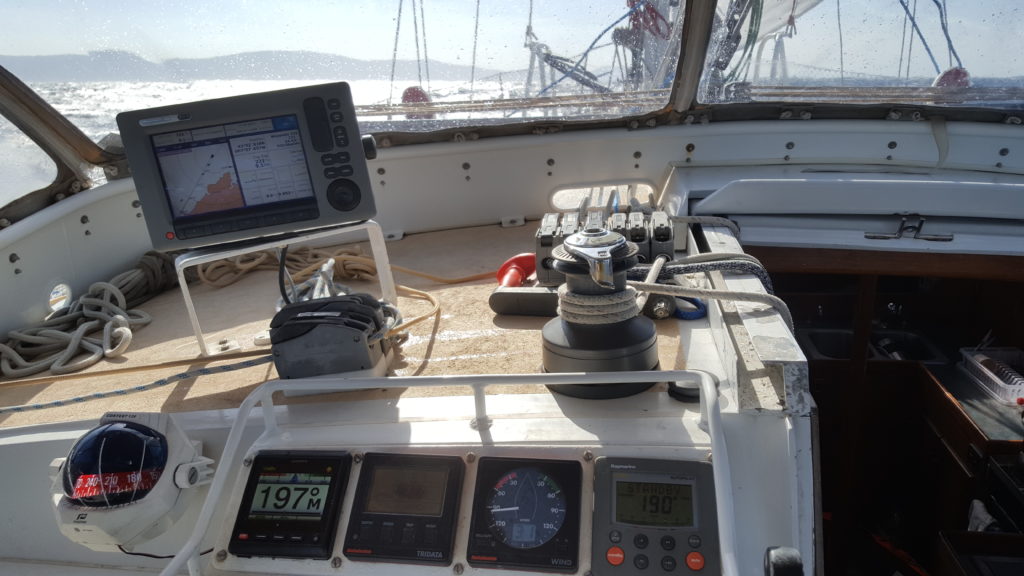
Difficile de se rendre compte avec une photo du bruit ambiant. Lucy fend les flots, GV basse.
Sitôt passé le Cap Ortegal, tout s’arrête. Il nous protège du vent, et donc de la houle. J’en profite pour rebrancher le capteur d’angle de barre du Raymarine. La même mésaventure nous était arrivée au printemps dernier, mais le pilote avait consenti à continuer à barrer à l’époque. Je ne sais pas ce qui a changé, mais nous aurions vraiment du consolider la fixation à l’époque plutôt que de réparer à l’identique. Sur un voilier, tout ce qui casse se doit d’être renforcé. On l’a lu plein de fois, mais on commence tout juste à comprendre.
Cette fois, l’Espagne est à portée de mains. On longe sa côte, on capte son GSM, tout juste si on ne discerne pas une odeur de tortillas. L’adrénaline n’est plus, mais elle a été remplacée par l’impatience d’arriver, et je ne dors toujours pas. Cette nuit, je sens qu’il faudra un ouragan pour me réveiller.
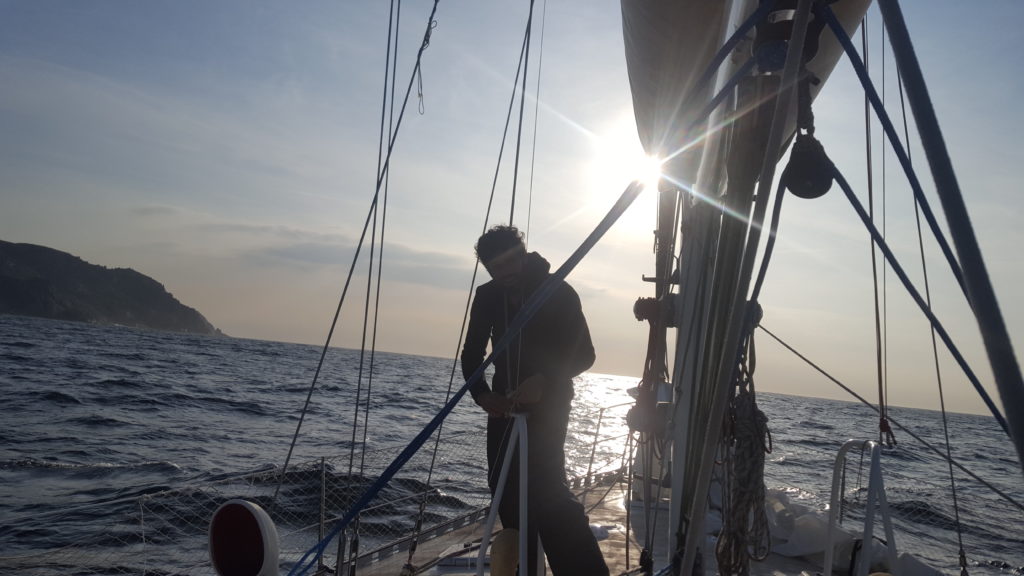
Je suis aussi doué pour hisser le pavillon espagnol que Sarah pour prendre des photos à contre-jour
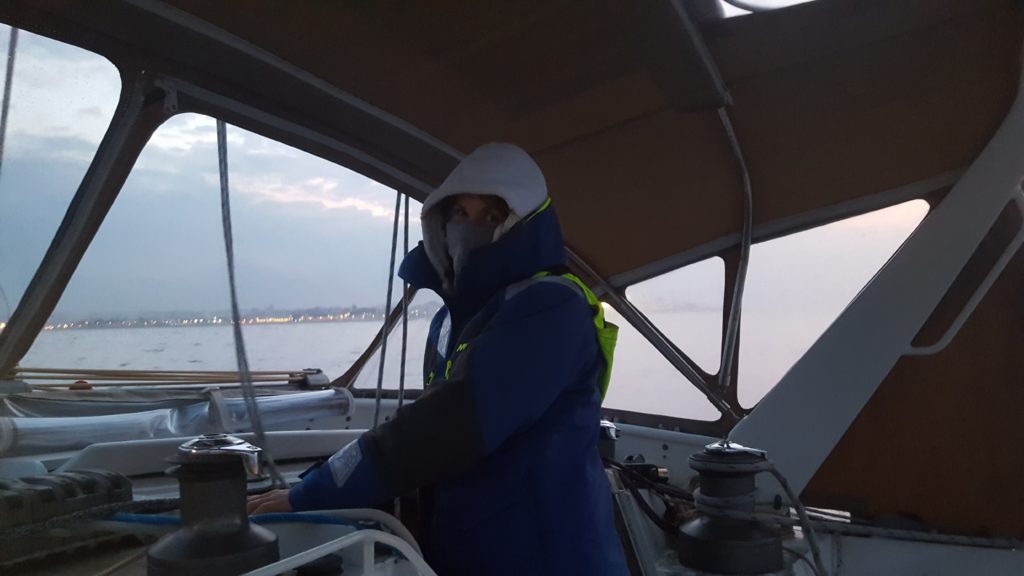
Qu’est ce que ce sera en Islande !
Il est 20h pour notre arrivée à la Corogne. Notre vitesse moyenne pour la traversée ? 6.1 noeuds. Sarah appelle à la VHF avec son meilleur espagnol et s’entend répondre en français. Elle est trop fatiguée pour être vexée. Fryderyk Chopin nous attend à quai, c’est un magnifique brick, ça aurait été quelque chose de tirer un bord avec lui dans ce coup de vent ! Les manœuvres de port qui nous terrifiaient il y a 6 petits mois sont une partie de plaisir dans une place si large ; Nous avons même le temps de prendre une douche chaude à la capitainerie avant qu’elle ne ferme. Demain, nous mangerons des tapas dans une rue animée. Pour l’instant, nous allons nous coucher.
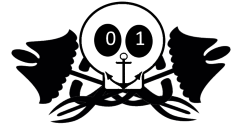
Waouh, vous progressez bien!
C’est l’aventure… et j’aimerais pas du tout être à votre place! 🙂
Exactement ce que je me dis à chaque fois que tu pars pour ta semaine de rodéo dans les Alpes 🙂
Je ne comprends pas tout à la partie technique. Mais vous avez l’air de vous débrouiller. Bon courage et prenez bien soin de vous.
Ps: si vous pouviez améliorer vos photos pour l’Islande, ce serait bien.
Oui on a décidé d’utiliser un vrai appareil photo au lieu de nos téléphones maintenant ! Pas sûr que les photos soient beaucoup plus réussies, mais au moins elles seront de meilleure qualité ! 😉
c est top ! Belle traversee !
A peu près aussi agitée que la votre il y a 2 mois si j’ai bien compris ! a très vite 🙂
Attendre des semaines les meilleures conditions météo pour traverser le golfe de Gascogne et, à cause d’un contretemps technique, partir en sachant que vous pouvez vous mettre en difficultés parce que vous en avez assez de la Trinité, hum ! Pas terrible les jeunes !!
Je vous envoie plein de bisous, régalez vous et restez prudents.
En fait la météo prévoyait une très bonne fenêtre ! Et même quand on a actualisé nos fichiers de vent au milieu du Golfe ils sous-estimaient de 10-15 noeuds au moins la force du vent… Et au final c’était inconfortable (à cause de la houle), mais pas dangereux du tout, et surtout plus rapide !! 😉